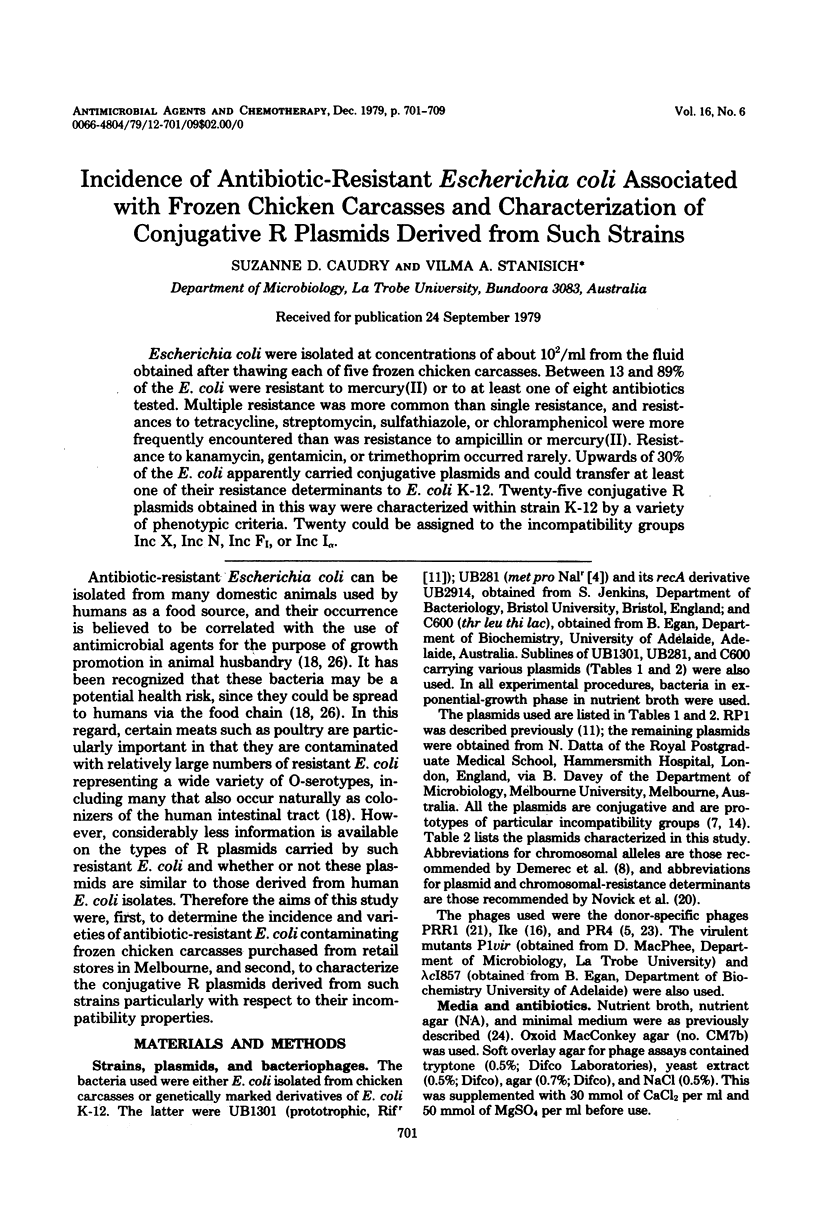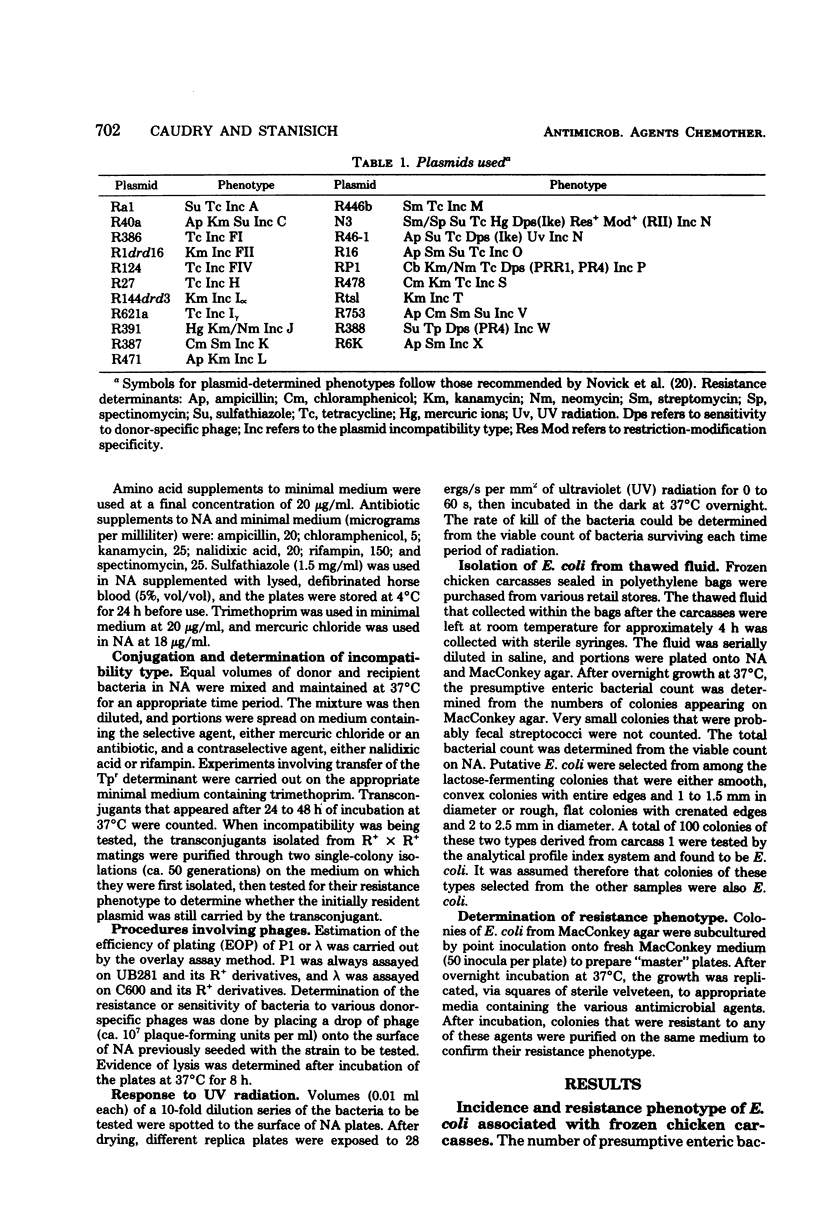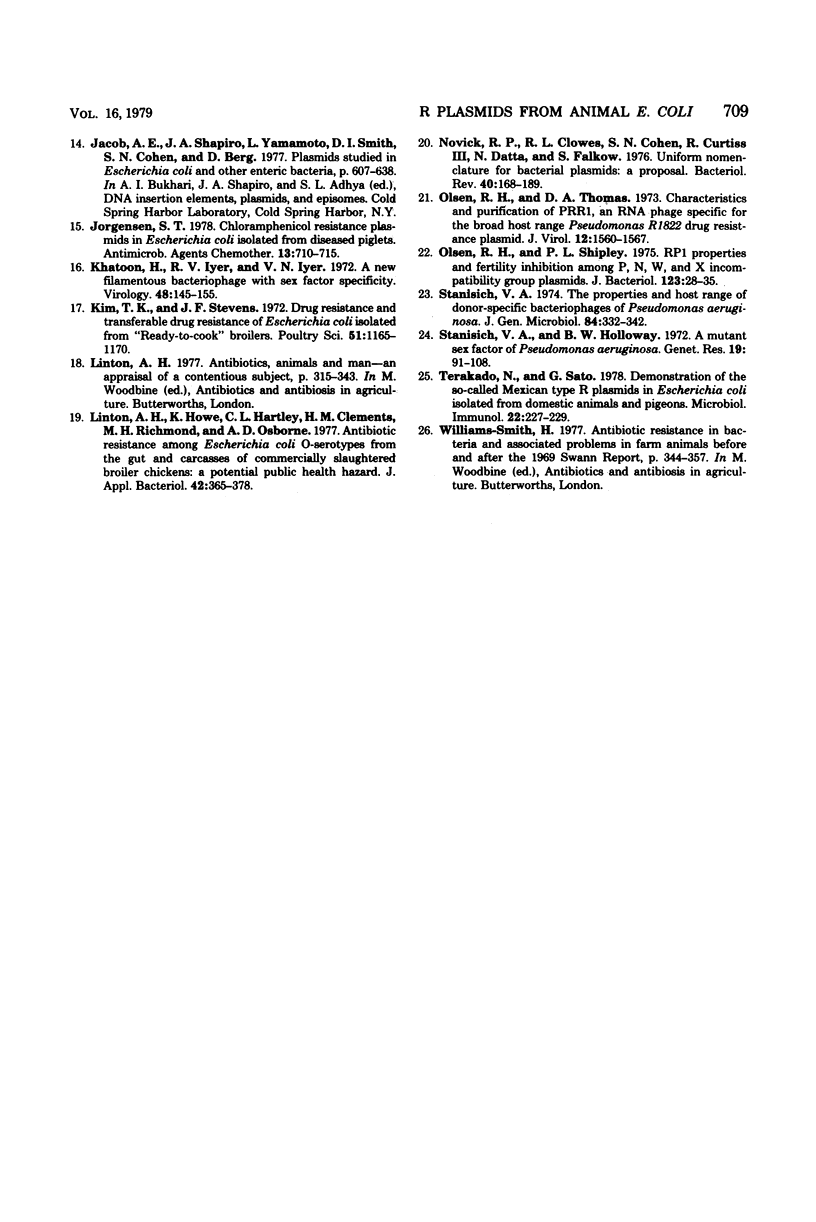Abstract
Escherichia coli were isolated at concentrations of about 10(2)/ml from the fluid obtained after thawing each of five frozen chicken carcasses. Between 13 and 89% of the E. coli were resistant to mercury(II) or to at least one of eight antibiotics tested. Multiple resistance was more common than single resistance, and resistances to tetracycline, streptomycin, sulfathiazole, or chloramphenicol were more frequently encountered than was resistance to ampicillin or mercury(II). Resistance to kanamycin, gentamicin, or trimethoprim occurred rarely. Upwards of 30% of the E. coli apparently carried conjugative plasmids and could transfer at least one of their resistance determinants to E. coli K-12. Twenty-five conjugative R plasmids obtained in this way were characterized within strain K-12 by a variety of phenotypic criteria. Twenty could be assigned to the incompatibility groups Inc X, Inc N, Inc FI, or Inc I alpha.
Full text
PDF








Selected References
These references are in PubMed. This may not be the complete list of references from this article.
- Anderson E. S., Threlfall E. J., Carr J. M., Savoy L. G. Bacteriophage restriction in Salmonella typhimurium by R factors and transfer factors. J Hyg (Lond) 1973 Sep;71(3):619–631. doi: 10.1017/s0022172400046611. [DOI] [PMC free article] [PubMed] [Google Scholar]
- Bannister D., Glover S. W. Restriction and modification of bacteriophages by R+ strains of Escherichia coli K12. Biochem Biophys Res Commun. 1968 Mar 27;30(6):735–738. doi: 10.1016/0006-291x(68)90575-5. [DOI] [PubMed] [Google Scholar]
- Bradley D. E., Rutherford E. L. Basic characterization of a lipid-containing bacteriophage specific for plasmids of the P, N, and W compatibility groups. Can J Microbiol. 1975 Feb;21(2):152–163. doi: 10.1139/m75-023. [DOI] [PubMed] [Google Scholar]
- Chaslus-Dancla E., Guillot J. F., Lafont J. P. Mise en évidence de plasmides appartenant au groupe d'incompatibilité incP conférant la résistance au chloramphénicol chez Escherichia coli d'origine aviaire. Ann Microbiol (Paris) 1978 Aug-Sep;129B(2):147–154. [PubMed] [Google Scholar]
- Demerec M., Adelberg E. A., Clark A. J., Hartman P. E. A proposal for a uniform nomenclature in bacterial genetics. Genetics. 1966 Jul;54(1):61–76. doi: 10.1093/genetics/54.1.61. [DOI] [PMC free article] [PubMed] [Google Scholar]
- Drabble W. T., Stocker B. A. R (transmissible drug-resistance) factors in Salmonella typhimurium: pattern of transduction by phage P22 and ultraviolet-protection effect. J Gen Microbiol. 1968 Aug;53(1):109–123. doi: 10.1099/00221287-53-1-109. [DOI] [PubMed] [Google Scholar]
- Grant A. J., Pittard J. Incompatibility reactions of R plasmids isolated from Escherichia coli of animal origin. J Bacteriol. 1974 Oct;120(1):185–190. doi: 10.1128/jb.120.1.185-190.1974. [DOI] [PMC free article] [PubMed] [Google Scholar]
- Grinsted J., Saunders J. R., Ingram L. C., Sykes R. B., Richmond M. H. Properties of a R factor which originated in Pseudomonas aeruginosa 1822. J Bacteriol. 1972 May;110(2):529–537. doi: 10.1128/jb.110.2.529-537.1972. [DOI] [PMC free article] [PubMed] [Google Scholar]
- Hedges R. W. Phenotypic characterization of fi- R factors determining the restriction and modification hsp II specificity. Mol Gen Genet. 1972;115(3):225–233. doi: 10.1007/BF00268886. [DOI] [PubMed] [Google Scholar]
- Howe K., Linton A. H., Osborne A. D. The effect of tetracycline on the coliform gut flora of broiler chickens with special reference to antibiotic resistance and O-serotypes of Escherichia coli. J Appl Bacteriol. 1976 Dec;41(3):453–464. doi: 10.1111/j.1365-2672.1976.tb00658.x. [DOI] [PubMed] [Google Scholar]
- Jørgensen S. T. Chloramphenicol resistance plasmids in Escherichia coli isolated from diseased piglets. Antimicrob Agents Chemother. 1978 May;13(5):710–715. doi: 10.1128/aac.13.5.710. [DOI] [PMC free article] [PubMed] [Google Scholar]
- Khatoon H., Iyer R. V., Iyer V. N. A new filamentous bacteriophage with sex-factor specificity. Virology. 1972 Apr;48(1):145–155. doi: 10.1016/0042-6822(72)90122-5. [DOI] [PubMed] [Google Scholar]
- Kim T. K., Stephens J. F. Drug resistance and transferable drug resistance of Escherichia coli isolated from "ready-to-cook" broilers. Poult Sci. 1972 Jul;51(4):1165–1170. doi: 10.3382/ps.0511165. [DOI] [PubMed] [Google Scholar]
- Linton A. H., Howe K., Hartley C. L., Clements H. M., Richmond M. H., Osborne A. D. Antibiotic resistance among Escherichia coli O-serotypes from the gut and carcases of commercially slaughtered broiler chickens: a potential public health hazard. J Appl Bacteriol. 1977 Jun;42(3):365–378. doi: 10.1111/j.1365-2672.1977.tb00704.x. [DOI] [PubMed] [Google Scholar]
- Novick R. P., Clowes R. C., Cohen S. N., Curtiss R., 3rd, Datta N., Falkow S. Uniform nomenclature for bacterial plasmids: a proposal. Bacteriol Rev. 1976 Mar;40(1):168–189. doi: 10.1128/br.40.1.168-189.1976. [DOI] [PMC free article] [PubMed] [Google Scholar]
- Olsen R. H., Shipley P. L. RP1 properties and fertility inhibition among P, N, W, and X incompatibility group plasmids. J Bacteriol. 1975 Jul;123(1):28–35. doi: 10.1128/jb.123.1.28-35.1975. [DOI] [PMC free article] [PubMed] [Google Scholar]
- Olsen R. H., Thomas D. D. Characteristics and purification of PRR1, an RNA phage specific for the broad host range Pseudomonas R1822 drug resistance plasmid. J Virol. 1973 Dec;12(6):1560–1567. doi: 10.1128/jvi.12.6.1560-1567.1973. [DOI] [PMC free article] [PubMed] [Google Scholar]
- Stanisich V. A., Holloway B. W. A mutant sex factor of Pseudomonas aeruginosa. Genet Res. 1972 Feb;19(1):91–108. doi: 10.1017/s0016672300014294. [DOI] [PubMed] [Google Scholar]
- Stanisich V. A. The properties and host range of male-specific bacteriophages of Pseudomonas aeruginosa. J Gen Microbiol. 1974 Oct;84(2):332–342. doi: 10.1099/00221287-84-2-332. [DOI] [PubMed] [Google Scholar]
- Terakado N., Sato G. Demonstration of the so-called Mexican type R plasmids in Escherichia coli isolated from domestic animals and pigeons. Microbiol Immunol. 1978;22(4):227–229. doi: 10.1111/j.1348-0421.1978.tb00366.x. [DOI] [PubMed] [Google Scholar]


